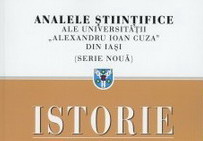Din corespondenţa episcopului Ioanichie al Romanului (1747-1769)
Excerpts from the correspondence of bishop Ioanichie of Roman (1747-1769)
Author(s): Mihai MîrzaSubject(s): History
Published by: Editura Universităţii »Alexandru Ioan Cuza« din Iaşi
Keywords: Ioanichie; Bishop of Roman; correspondence; church; Precista Monastery in Roman
Summary/Abstract: This study is actually a critical presentation of the 17 letters of Ioanichie, Bishop of Roman, chief hierarch in the 18th century, letters which the author has found in several collections of public archives in Bucharest and Iasi. The letters will be published in the annex. The Romanian clerical and lay elites of the 18th century (boyars, merchants, bishops, hegumens, etc.) used correspondence in order to keep in touch. In a century in which the postal services used to attend exclusively to the state interests - of the rule - letters were sent, obviously folded and sealed with the personal seal usually applied in black wax, by means of servants, close persons or acquaintances. Few documents have been less doomed than letters. Being private documents of immediate interest, letters were usually destroyed in many cases shortly after they were read, or simply left adrift. Thus, few letters have made it through hostile times, coming up to us. Bishop Ioanichie frequently wrote to and received letters from his relatives and collaborators. Among them, there was a certain Ioan, the bishop's nephew and right-hand man, whom he designated hegumen at the monastery Precista of Roman, which he had founded; others were the high steward Lupul Crupenschi, the lord steward Gavril Caracaş, the cup bearer Petrache Vidali, etc. Interesting are the letters he received from Constantin Racoviţă, Prince of Moldavia, with whom he built and granted two monasteries, the Precista monastery of Roman and St. Prophet Samuil of Focsani. The three letters he received from Racoviţă are about endowing these two monasteries. Six letters are sent by the bishop to his nephew and they refer to the problem of submitting Precista Mare monastery to the guardianship of St. Spiridon monastery, to whom it has been abusively rendered by Ştefan Racoviţă, Prince of Wallachia, on September 7th, 1765. These letters reflect the Bishop's turmoil, having deferred as long as possible the moment in which the church constructed from his own donations would be assigned to the hegumen of St. Spiridon monastery. These letters contain interesting and unique information about certain social practices and mores, and as well about how the Moldavia of that time was socially structured, about the operating principles of state institutions, the good or the bad health of the elite, about the rumours of the time and how people perceived news from abroad. Thus, in the summer of 1762, a most disturbing news used to travel through Moldavia - that Tsar Peter III of Russia had been assassinated, and in his place was now “his empress”, Catherine, later styled “the Great”.
Journal: Analele Ştiinţifice ale Universităţii »Alexandru Ioan Cuza« din Iaşi. Istorie
- Issue Year: 2014
- Issue No: 60
- Page Range: 275-305
- Page Count: 31
- Language: Romanian
- Content File-PDF

